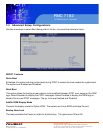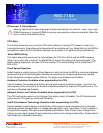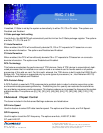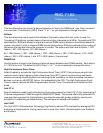
661 Brea Canyon Rd., Suite 3
Walnut, CA 91789
tel: 909.598.7388, fax: 909.598.0218
© Copyright 2005 Acnodes, Inc.
All rights reserved. Product description and product specifications
are subject to change without notice. For latest product information,
please visit Acnodes’ web site at www.acnodes.com.
RMC 7182
1U Rackmount System
Air Flow
This item allows the user to set the desired speed of air flow to the DIMM mod- ules. Each increment
is one mm/sec. The default is [1500]. Press "+" or "-" on your keyboard to change this value.
Altitude
This item allows the user to specify the altitude of the location where the com- puter is used. For
Tylersburg-EP platforms, system memory thermal solution is derated up to 900m. To comply with CPU
specifications, BIOS will attempt to adjust and correct DIMM velocity based on the altitude where the
system is located in order to improve DIMM thermal performance. Altitude is defined as the number of
feet above the sea level where the computer is located. The options are Sea Level or Below, 1~300
(above-), 301~600 (above-), 601~900 (above-),
901~1200 (above-), 1201~1500 (above-), 1501~1800 (above-), 1801~2100 (above-), 2101~2400
(above-), 2401~2700 (above-), and 2701~3000 (above-) the sea level.
DIMM Pitch
Use this feature to specify the distance of physical space between each DIMM module. Each step is
in 1/1000 of an inch. The default is [400]. Press "+" or "-" on your keyboard to change this value.
High Performance Event Timer
Select Enabled to activate the High Performance Event Timer (HPET) that produces periodic inter-
rupts at a much higher frequency than a Real-time Clock (RTC) does in synchronizing multimedia
streams, providing smooth playback and reducing the de- pendency on other timestamp calculation
devices, such as an x86 RDTSC Instruc- tion embedded in the CPU. The High Performance Event
Timer is used to replace the 8254 Programmable Interval Timer. The options are Enabled and Dis-
abled.
Intel VT-d
Select Enabled to enable Intel's Virtualization Technology support for Direct I/O VT-d by reporting the I/
O device assignments to VMM through the DMAR ACPI Tables. This feature offers fully-protected I/O
resource-sharing across the Intel platforms, providing the user with greater reliability, security and
availability in networking and data-sharing. The settings are Enabled and Disabled.
Intel I/OAT
The Intel I/OAT (I/O Acceleration Technology) significantly reduces CPU overhead by leveraging CPU
architectural improvements, freeing resources for more other tasks. Available options are Disabled
and Enabled.


















